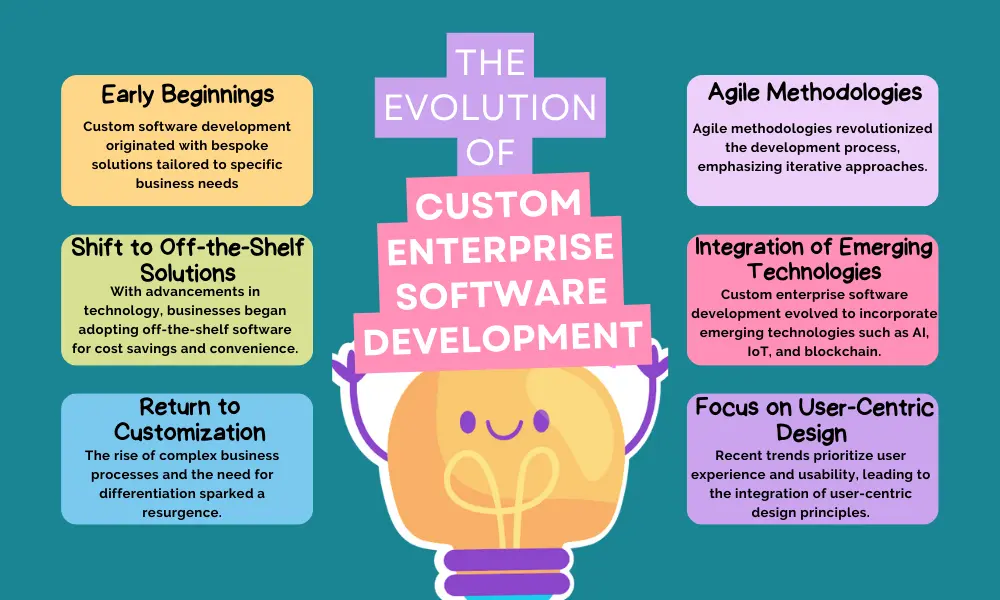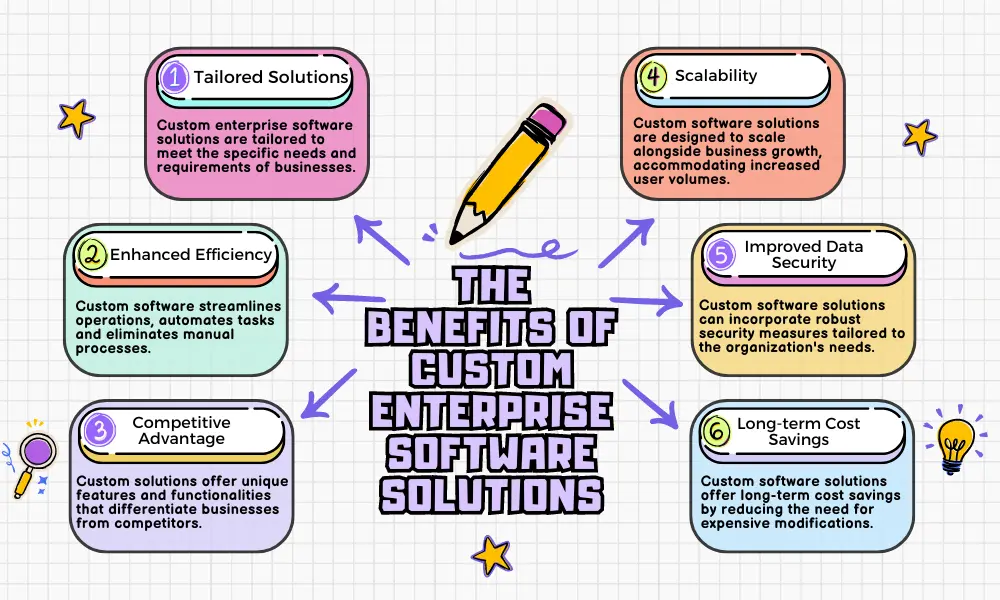In an era defined by technological advancements and digital transformation, custom enterprise software development stands as a cornerstone for USA businesses striving to stay competitive and innovative in their respective industries. As businesses seek to streamline operations, enhance efficiency, and deliver superior customer experiences, the demand for tailored software solutions has surged exponentially.
According to recent research by Statista, the global enterprise software market is projected to reach a staggering $575 billion by 2028, reflecting the growing reliance on software solutions to drive business growth and success. Within this landscape, face unique challenges and complexities in custom enterprise software development, influenced by factors such as regulatory requirements, market dynamics, and evolving consumer preferences.
One of the primary challenges encountered is the need for software solutions that are not only tailored to their specific operational requirements but also compliant with stringent regulatory standards. For instance, industries such as healthcare and finance must navigate complex regulatory frameworks, such as HIPAA and Sarbanes-Oxley, which impose strict guidelines on data security and privacy.
Furthermore, the rapid pace of technological innovation presents both opportunities and challenges for USA businesses embarking on enterprise software development services initiatives. Emerging technologies like AI, ML, and IoT offer huge potential for business. But, adding them to existing software needs careful planning and execution.
Moreover, the scalability and flexibility of custom enterprise software solutions are paramount for USA businesses, especially in dynamic and rapidly evolving market environments. We delve into the key challenges USA businesses face in custom enterprise software development and explore effective strategies and solutions to overcome them. Our insights empower them to navigate software complexity and achieve their business goals.
Ready to Build? Let’s Create Your Software Solution Today!
Understanding The Landscape of Custom Enterprise Software Development
Custom enterprise software development encompasses the creation of tailored solutions to address the specific needs of businesses, ranging from small startups to large corporations. This landscape is shaped by various factors including technological advancements, market trends, and evolving business requirements.
Grand View Research found that the global custom software market was worth USD 131.03 billion in 2020. They expect it to grow at a rate of 10.7% from 2021 to 2028. This growth is driven by the increasing demand for personalized software solutions that can enhance operational efficiency, improve customer experiences, and enable business innovation.
Key trends in custom enterprise software development include the adoption of cloud-based solutions, which offer scalability, flexibility, and cost-effectiveness. Additionally, there is a growing emphasis on leveraging emerging technologies such as machine learning (ML), blockchain, the Internet of Things (IoT), and artificial intelligence in software development to create intelligent and interconnected systems that can drive digital transformation.
Agile and DevOps methodologies have become prevalent in custom software development, enabling faster time-to-market, continuous integration, and iterative development cycles. Collaboration tools and platforms help distributed development teams. They aid in communication and coordination. They support seamless project management and collaboration.
Security remains a paramount concern in custom enterprise software development, with a focus on implementing robust cybersecurity measures to protect sensitive data and mitigate potential threats. Compliance with regulatory standards such as GDPR, HIPAA, and PCI-DSS is also crucial for ensuring legal and ethical standards are met.
The landscape of custom enterprise software development is dynamic and continuously evolving, driven by technological advancements, market demands, and changing business requirements. Best custom software development companies that embrace these trends and leverage custom software solutions can gain a competitive edge and position themselves for success in today’s digital economy.

Exploring the Importance of Custom Enterprise Software Development
Custom enterprise software development plays a pivotal role in modern business operations, offering tailored solutions to meet the unique needs and challenges of organisations across various industries. As businesses strive for digital transformation and competitive advantage, the importance of custom software development cannot be overstated. In this exploration, we delve into the key reasons why custom enterprise software development is essential for businesses today.
1. Alignment with Specific Business Needs
Firstly, Custom enterprise software development enables custom software development companies in USA to address their specific operational requirements, workflows, and challenges. Off-the-shelf solutions may not adequately cater to the nuances of a business’s processes, making custom development crucial for achieving optimal alignment.
2. Enhanced Efficiency and Productivity
Secondly, Tailored software solutions streamline business processes, automate repetitive tasks, and eliminate inefficiencies, leading to improved productivity and operational efficiency. By optimizing workflows and integrating disparate systems, custom software solutions empower organizations to accomplish more with fewer resources.
3. Competitive Differentiation
In today’s competitive landscape, innovation is key to staying ahead. Custom enterprise software development allows businesses to differentiate themselves by implementing unique features, functionalities, and user experiences that set them apart from competitors. This differentiation can be a significant driver of market positioning and customer loyalty.
4. Scalability and Flexibility
Custom software solutions are designed to scale alongside the growth of an organization, accommodating increased user volumes, expanding functionalities, and evolving business requirements. Unlike off-the-shelf software, which may have limitations in scalability and flexibility, custom solutions can adapt to changing needs without major disruptions.
5. Data Security and Compliance
Custom enterprise software development enables software development outsourcing services to implement robust security measures tailored to their specific security needs and compliance requirements. With rising concerns about data breaches and regulatory compliance, custom solutions offer greater control and assurance over data protection and adherence to industry standards.
6. Integration Capabilities
Custom software can fit with existing systems and third-party apps. It helps data exchange, interoperability, and collaboration across departments and stakeholders. Integration capabilities are crucial for optimizing processes, improving decision-making, and driving organisational efficiency.
7. Long-term Cost Savings
Lastly, While custom software development may involve higher upfront costs compared to off-the-shelf solutions, the long-term benefits often outweigh the initial investment. Custom solutions are designed to meet the evolving needs of an organization, reducing the need for costly modifications, workarounds, or replacements in the future.
Custom enterprise software development offers a multitude of benefits, ranging from tailored solutions to enhanced efficiency, competitive differentiation, scalability, security, integration, and long-term cost savings. By investing in custom software development, organizations can use technology as a strategic asset. It can drive innovation, growth, and success in today’s fast-changing business environment.
The Role of Technology in Driving Innovation for USA Businesses
Technology plays a pivotal role in driving innovation for businesses across the United States, serving as a catalyst for growth, efficiency, and competitive advantage. From small startups to large corporations, custom software development outsourcing companies leverage technological advancements to create new products, improve processes, and disrupt traditional industries. In this exploration, we delve into the multifaceted role of technology in fostering innovation within USA businesses.
1. Enabling Digital Transformation
Firstly, Technology enables USA businesses to go digital. They do this by digitizing processes, adopting the cloud, and using data analytics. Digital transformation drives efficiency, agility, and customer-centricity, paving the way for innovation in product development, marketing strategies, and customer experiences.
2. Facilitating Collaborative Work Environments
Secondly, Advanced communication and collaboration technologies, such as video conferencing, project management tools, and collaborative platforms, facilitate seamless teamwork and knowledge sharing. By breaking down geographical barriers and enabling real-time collaboration, technology fosters a culture of innovation where ideas can be exchanged and refined across diverse teams.
3. Empowering Data-driven Decision Making
Big data analytics, artificial intelligence (AI), and machine learning (ML) empower USA businesses to extract valuable insights from vast amounts of data. Businesses can use data-driven processes. They can use them to identify trends and foresee customer needs. They can also use them to improve operations. This leads to informed strategy and new solutions.
4. Fostering Entrepreneurship and Startups
Technology lowers barriers to entry and fosters a conducive environment for entrepreneurship and startups in the USA. They can use online resources, cloud computing, and open-source software. These tools let aspiring entrepreneurs make products and services more cheaply and efficiently. This drives economic growth and job creation.
5. Driving Industry Disruption and Innovation
Technology disrupts traditional industries and business models, leading to the emergence of innovative solutions and new market opportunities. Custom software development services leverage technologies such as blockchain, the Internet of Things (IoT), and augmented reality (AR) to revolutionize sectors such as finance, healthcare, transportation, and manufacturing, driving innovation and creating value for consumers.
6. Enhancing Customer Experiences
Technology enables USA businesses to deliver personalised and seamless customer experiences across various touchpoints. From e-commerce platforms to mobile apps and social media interactions, businesses leverage technology to understand customer preferences, tailor offerings, and provide exceptional service, driving customer satisfaction and loyalty.
7. Promoting Regulatory Compliance and Cybersecurity
Lastly, In an increasingly regulated environment, technology plays a crucial role in ensuring regulatory compliance and cybersecurity for USA businesses. Businesses can protect sensitive data from cyber threats with robust cybersecurity measures, encryption, and compliance systems. They can also maintain trust with customers and stakeholders.
Technology drives innovation for USA businesses. Custom enterprise software development plays a pivotal role in driving digital transformation, fostering collaboration, empowering data-driven decision-making, and promoting entrepreneurship. It facilitates industry disruption, enhances customer experiences, and ensures regulatory compliance and cybersecurity. By leveraging custom software solutions, businesses can innovate, streamline operations, and stay ahead in today’s dynamic business landscape.By embracing technology as a strategic enabler, USA businesses can unlock new opportunities, drive growth, and maintain a competitive edge in today’s dynamic business landscape.
Transform Your Business with Custom Enterprise Software. Request a Free Consultation Today!
Identifying Common Challenges in Custom Enterprise Software Development
Custom enterprise software development presents numerous opportunities for businesses to address specific needs and gain a competitive edge. However, it also comes with its set of challenges that can impact project success and delivery. Understanding these challenges is crucial for effectively navigating the custom software development process. In this discussion, we explore some of the common challenges encountered in custom enterprise software development.
1. Requirements Gathering and Scope Creep
Firstly, One of the initial challenges in software development consulting services is accurately gathering and defining requirements. Misaligned expectations between stakeholders, evolving business needs, and scope creep can lead to project delays, increased costs, and dissatisfaction with the final product.
2. Resource Constraints and Talent Acquisition
Secondly, Finding skilled developers and technical experts with the right expertise can be challenging, particularly in specialised domains or emerging technologies. Resource constraints, including limited budgets and availability of qualified personnel, can hinder project execution and quality.
3. Complexity and Integration Issues
Custom software solutions often need to integrate with existing systems, third-party applications, or legacy infrastructure. Managing integration is hard. It requires ensuring interoperability and data consistency. This is tough because the systems are disparate. They pose big challenges during development and implementation.
4. Communication and Collaboration
Effective communication and collaboration among stakeholders, including digital transformation services, developers, project managers, and quality assurance teams, are critical for project success. Bad communication leads to misunderstandings. It causes delays in decision-making. Ultimately, it leads to misalignment between the software and business goals.
5. Risk Management and Uncertainty
Custom software development projects inherently involve risks, including technical complexities, changing requirements, and unforeseen challenges. Effective risk management strategies, proactive identification of potential issues, and contingency planning are essential to mitigate project risks and ensure successful delivery.
6. Quality Assurance and Testing
Ensuring the reliability, performance, and security of custom software solutions requires thorough testing and quality assurance processes. But, few tests, poor coverage, and changing requirements can hurt testing. This leads to post-deployment issues and customer dissatisfaction.
7. Adaptability and Scalability
Custom software solutions need to be adaptable and scalable to accommodate future growth, technological advancements, and changing business needs. However, designing for adaptability and scalability from the outset requires careful planning, architectural decisions, and ongoing maintenance efforts to avoid performance bottlenecks and system limitations.
8. Regulatory Compliance and Security
Lastly, Meeting regulatory requirements, data privacy regulations, and security standards is paramount for software development consulting services, particularly in highly regulated industries such as finance, healthcare, and government. Ensuring compliance with industry regulations and implementing robust security measures require dedicated resources and expertise.
Custom enterprise software development has many challenges. These include gathering requirements. Also, limited resources, complex integration, communication issues, risk management, quality assurance, adaptability, and compliance with regulations. Addressing these challenges requires proactive planning, effective communication, collaboration, and a focus on delivering high-quality solutions that align with business objectives.
Solutions and Strategies for Successful Custom Enterprise Software Development
Successful custom enterprise software development requires careful planning, effective strategies, and proactive approaches to address various challenges and ensure project success. By implementing the right solutions and strategies, businesses can mitigate risks, streamline processes, and deliver high-quality software solutions that meet their specific needs. In this discussion, we explore key solutions and strategies for achieving success in enterprise software development services.
1. Comprehensive Requirements Analysis
Firstly, Conducting a thorough requirements analysis, involving stakeholders from different departments ensures a clear understanding of project objectives, user needs, and technical specifications. Utilizing techniques such as user stories, wireframes, and prototypes helps validate requirements and minimize scope creep.
2. Agile Development Methodology
Secondly, Adopting an agile development approach facilitates iterative development, frequent feedback cycles, and adaptive planning. Agile methodologies such as Scrum or Kanban promote collaboration, transparency, and flexibility, allowing teams to respond to changing requirements and deliver incremental value to stakeholders.
3. Effective Communication and Collaboration
Establishing open channels of communication and fostering collaboration among cross-functional teams is essential for project success. Regular meetings, status updates, and collaboration tools promote transparency, alignment, and shared understanding, enabling teams to address issues promptly and make informed decisions.
4. Risk Management and Contingency Planning
Identifying potential risks, assessing their impact and likelihood, and developing mitigation strategies are critical for minimizing project risks. Creating a risk register, conducting risk assessments, and defining contingency plans empower teams to proactively manage uncertainties and respond effectively to unforeseen challenges.
5. Continuous Integration and Testing
Implementing continuous integration (CI) and automated testing practices streamline the software development lifecycle, improve code quality, and accelerate delivery cycles. Automated testing frameworks, including unit tests, integration tests, and regression tests, ensure early detection of defects and facilitate rapid feedback loops to hire software developers.
6. Scalable Architecture and Modular Design
Designing a scalable architecture and adopting a modular approach facilitate flexibility, maintainability, and scalability of custom ERP software development. Utilizing microservices architecture, containerization technologies, and scalable cloud infrastructure enables seamless horizontal and vertical scaling to accommodate changing demands and future growth.
7. Quality Assurance and Code Reviews
Prioritizing quality assurance practices, including code reviews, static code analysis, and peer testing, helps identify and address defects early in the development process. Implementing coding standards, code quality metrics, and automated code review tools ensures consistency, readability, and maintainability of codebases.
8. User Training and Change Management
Providing comprehensive user training and change management support ensures the successful adoption and utilization of custom software solutions. Offering user documentation, training sessions, and ongoing support services helps users navigate the transition, embrace new technologies, and maximize the value of the software solution.
9. Post-Deployment Support and Maintenance
Lastly, Offering post-deployment support, maintenance services, and software updates is crucial for sustaining the performance, security, and reliability of an enterprise software development company. Establishing service level agreements (SLAs), monitoring system performance, and addressing customer feedback ensure continuous improvement and customer satisfaction.
Implementing clear requirements analysis is vital. So are agile development methods, good communication, risk management, continuous integration, scalable architecture, quality assurance, user training, and post-deployment support. These are key strategies for successful custom enterprise software development. By prioritizing these approaches, businesses can mitigate risks, optimize processes, and deliver high-quality software solutions that drive business value and innovation.
What are Security Concerns in Custom Enterprise Software Development?
Security concerns in custom enterprise software development are paramount due to the sensitive nature of data and operations within businesses. Custom software solutions are tailored to meet specific organizational needs. They often bring unique security challenges. These require careful consideration and mitigation. In this discussion, we delve into some of the key security concerns that arise during custom enterprise software development.
1. Data Security
Firstly, Protecting sensitive data, including customer information, intellectual property, and proprietary business data, is a primary concern in custom enterprise software development. Unauthorized access, data breaches, and data leaks can harm businesses. They cause financial losses, reputational damage, and regulatory non-compliance.
2. Authentication and Access Control
Secondly, Implementing strong authentication and access control is essential. It stops unauthorized users from accessing sensitive resources in custom software. Weak authentication methods, such as simple passwords or lack of multi-factor authentication, can expose systems to credential theft and unauthorized access.
3. Vulnerability Management
Identifying and addressing security vulnerabilities, including software flaws, misconfigurations, and outdated libraries, is crucial for maintaining the security posture of custom software solutions. Regular vulnerability assessments, patch management processes, and security updates help mitigate the risk of exploitation by malicious actors.
4. Secure Development Practices
Secure coding requires practices like input validation, output encoding, and error handling. They are key for reducing the risk of common security bugs, such as injection attacks, cross-site scripting (XSS), and buffer overflows. Adding security requirements to the software development lifecycle (SDLC) and doing secure code reviews help find and fix security flaws early.
5. Secure Configuration Management
Properly configuring servers, databases, and network infrastructure is essential for minimizing security risks in custom ERP software development environments. Hardening systems, disabling unnecessary services, and implementing least privilege access controls help reduce the attack surface and mitigate the impact of security incidents.
6. Encryption and Data Protection
Encrypting sensitive data at rest and in transit helps protect it from unauthorized access and interception by malicious entities. We use encryption algorithms, secure protocols, and key management. They keep data in custom software secret unaltered and authentic.
7. Secure Integration and APIs
Securely integrating custom software solutions with third-party systems, external APIs, and cloud services requires careful consideration of security implications. Implementing secure communication protocols, validating input data, and enforcing proper authorization mechanisms help mitigate the risk of API abuse and data breaches.
8. Incident Response and Disaster Recovery
Lastly, Developing robust incident response plans and disaster recovery strategies is essential for mitigating the impact of security incidents and ensuring business continuity. Having clear escalation procedures helps. So does doing regular security drills. And keeping backups of critical data does too. These things reduce downtime and help recovery from breaches.
Security concerns in enterprise software development services encompass data security, authentication, vulnerability management, secure development practices, configuration management, encryption, secure integration, and incident response. By addressing these concerns proactively and using security best practices in the software development lifecycle, businesses can reduce risks. They can also protect sensitive assets and keep the integrity and confidentiality of their custom software.
Unlock Your Business Potential with Custom Enterprise Software Solutions. Book a Free Consultation Today!
How to Ensure Compatibility and Integration in Custom Enterprise Software Development?
Ensuring compatibility and seamless integration are critical aspects of custom enterprise software development, especially in today’s interconnected business landscape. Custom software must fit with existing systems, third-party apps, and diverse tech. They should do this smoothly to be efficient and effective. In this discussion, we explore strategies for ensuring compatibility and integration in custom enterprise software development.
1. Comprehensive Compatibility Analysis
Firstly, Conduct a thorough analysis of existing systems, databases, and infrastructure to identify compatibility requirements and constraints. Understand the technology stack, data formats, communication protocols, and dependencies on application re engineering services to ensure compatibility with the custom software solution.
2. Standardization of Technologies and Protocols
Secondly, Standardize technologies, protocols, and communication interfaces to facilitate interoperability and compatibility across different systems and platforms. Adopt industry-standard formats, such as JSON or XML for data exchange, and widely accepted communication protocols, such as RESTful APIs or SOAP, to simplify integration efforts.
3. API-First Development Approach
Embrace an API-first development approach to design custom software solutions with well-defined application programming interfaces (APIs). APIs serve as the bridge for integrating with other systems and applications, enabling seamless data exchange and functionality interoperability.
4. Modular Architecture and Service-Oriented Design
Design custom software solutions with a modular architecture and service-oriented design principles to promote reusability, scalability, and interoperability. Break down complex systems into smaller, loosely coupled components or microservices that can be independently developed, deployed, and integrated.
5. Use of Integration Middleware
Employ integration middleware or enterprise service bus (ESB) solutions to facilitate communication and data exchange between disparate systems. Middleware enables centralized management of integration points. It also orchestrates workflows and transforms data formats. This ensures compatibility and interoperability.
6. Data Mapping and Transformation
Implement robust data mapping and transformation mechanisms to harmonize data formats, structures, and semantics across integrated systems. Define mapping rules, data transformation pipelines, and validation processes to ensure data consistency, integrity, and accuracy during integration.
7. Testing and Validation Across Environments
Conduct comprehensive testing and validation across different environments, including development, staging, and production, to verify compatibility and integration integrity. Perform integration testing, end-to-end testing, and regression testing to validate data flows, system interactions, and functionality across integrated components for software re engineering services.
8. Continuous Monitoring and Maintenance
Establish monitoring mechanisms and performance metrics to track compatibility issues, integration failures, and system performance over time. Implement proactive monitoring, logging, and alerting systems to detect anomalies, troubleshoot integration errors, and ensure ongoing compatibility and integration stability.
9. Collaboration with Stakeholders and Vendors
Lastly, Foster collaboration and communication with internal stakeholders, external vendors, and third-party providers involved in the integration process. Clearly define integration requirements, expectations, and responsibilities to ensure alignment and accountability throughout the development and integration lifecycle.
Making custom enterprise software compatible and integrated requires a holistic approach. It includes compatibility analysis, using standard technologies, API-first development, modular architecture, integration middleware, data mapping, testing, monitoring, and collaboration. By following these strategies, custom software development services can overcome compatibility challenges, streamline integration efforts, and achieve seamless interoperability across their custom software solutions and existing IT ecosystems.
Strategies for Successful Implementation of Custom Enterprise Software
Businesses must implement custom enterprise software successfully. This is crucial for streamlining operations, boosting productivity, and gaining a competitive edge. However, the implementation process can be complex, requiring careful planning, coordination, and execution to ensure project success. In this discussion, we explore strategies for effectively implementing custom enterprise software solutions to maximize their value and impact on business operations.
1. Define Clear Objectives and Requirements
Firstly, Begin by defining clear objectives and requirements for the custom enterprise software solution. Engage stakeholders from different departments to gather input, prioritize features, and establish measurable goals that align with the best custom software development companies strategic objectives and business needs.
2. Select the Right Development Partner
Secondly, Choose a reputable and experienced development partner with a proven track record of delivering successful custom software solutions. Evaluate potential partners based on their technical expertise. Consider their industry experience, project management abilities, and communication skills. This will ensure a good partnership.
3. Agile Project Management Approach
Adopt an agile project management approach to promote flexibility, responsiveness, and adaptability throughout the implementation process. Break down the project into manageable sprints, prioritize features based on business value, and iterate on the software solution based on continuous feedback from stakeholders.
4. Comprehensive Training and Change Management
Provide thorough training. Also, give change management support. Do this to ensure that end-users smoothly adopt and use the custom enterprise software. Develop training materials, conduct user workshops, and offer ongoing support to address user questions, concerns, and feedback effectively.
5. Phased Rollout and User Acceptance Testing
Implement a phased rollout strategy to gradually introduce the custom software solution to users, starting with pilot groups and expanding to broader user groups over time. Conduct thorough user acceptance testing (UAT) to validate functionality, usability, and performance before full deployment.
6. Data Migration and System Integration
Plan and carry out data migration and system integration carefully. Do so to ensure a smooth transition and work with existing systems and databases. Develop data migration scripts, perform data validation, and conduct integration testing to minimize disruptions and data inconsistencies.
7. Performance Monitoring and Optimization
Establish performance monitoring mechanisms to track system performance, stability, and user satisfaction post-implementation. Monitor key performance indicators (KPIs), identify performance bottlenecks, and implement optimization measures to enhance system scalability, reliability, and responsiveness.
8. Continuous Improvement and Feedback Loop
Foster a culture of continuous improvement by soliciting feedback from users, gathering insights from system usage data, and prioritizing enhancements based on evolving custom software development companies in USA requirements. Implement regular software updates, bug fixes, and feature enhancements to keep the custom enterprise software solution aligned with changing business needs.
9. Compliance and Security Measures
Lastly, Ensure compliance with industry regulations, data privacy laws, and security standards throughout the implementation process. Use robust security measures. These include encryption protocols and access controls. They protect sensitive data and reduce cybersecurity risks from the custom enterprise software solution.
Succeeding with custom enterprise software requires: setting clear goals. You must choose the right partner and use agile project management. You also need to provide good training and change management. Rolling out in phases is key. You must manage data migration and system integration. You also must monitor performance and ask for feedback. And, you must ensure compliance and security while prioritizing improvement. By following these strategies, businesses can maximize the value and impact of their custom enterprise software. It will boost organizational efficiency, innovation, and competitiveness.
Conclusion
Developing custom enterprise software for USA businesses has many challenges. These include requirements gathering, resource limits, integration complexity, and security concerns. However, by implementing proactive strategies and leveraging best practices, these challenges can be effectively addressed to ensure successful project outcomes.
Strategies such as comprehensive requirements analysis, agile development methodologies, effective communication, risk management practices, continuous integration, scalable architecture, quality assurance, user training, and post-deployment support are essential for overcoming the key challenges in custom enterprise software development.
According to research by Grand View Research, the global custom software development market size was valued at USD 131.03 billion in 2020 and is expected to expand at a compound annual growth rate (CAGR) of 10.7% from 2021 to 2028. This growth shows that demand for custom software is rising. It also shows the importance of solving challenges well. Doing so lets companies take advantage of market opportunities and succeed.
Also, working with stakeholders is key. So is choosing experienced partners. And, following industry standards helps. Finally, prioritizing compliance and security also helps. By using these strategies, US businesses can navigate the complexities of custom software development. Finally, they can also improve processes and deliver high-quality solutions. These solutions drive innovation, efficiency, and competitive advantage in today’s dynamic business environment.
Answers to Common Questions About Custom Enterprise Software Development
1. What is custom enterprise software development?
Custom enterprise software development involves making tailored software solutions. They are designed to address the unique needs of a particular business or organization. We develop these solutions from scratch or customize them from existing frameworks. They meet specific business goals, streamline processes, and boost efficiency.
2. Why is custom enterprise software development important?
Custom enterprise software development is important. It enables businesses to create solutions that perfectly fit their unique workflows, processes, and objectives. Off-the-shelf software may not fully meet the specific needs of a business, leading to inefficiencies or limitations. Custom solutions, on the other hand, offer flexibility, scalability, and the ability to incorporate specialized features tailored to the software development outsourcing services requirements.
3. How long does custom enterprise software development take?
The timeline for custom enterprise software development can vary a lot. It depends on factors like project complexity, requirements scope, resource availability, and the development method chosen. Small-scale projects may take a few months to complete, while larger and more complex projects could take a year or more. It’s essential to work closely with the development team to establish realistic timelines and milestones based on project requirements.
4. What are the key steps involved in custom enterprise software development?
The key steps in custom enterprise software development typically include requirements gathering, analysis, design, development, testing, deployment, and maintenance. During requirements gathering, the team works closely with stakeholders. They aim to understand business goals and define project needs. The design phase involves creating a blueprint for the software solution. Development focuses on coding and putting the blueprint into action. Testing ensures the solution meets quality standards, and deployment involves launching the software for use. Maintenance involves ongoing support, updates, and enhancements.
5. How can I ensure the success of my custom enterprise software development project?
To ensure the success of a custom enterprise software development project, it’s crucial to establish clear objectives, communicate effectively with the custom software development consulting companies, and prioritize collaboration and feedback throughout the process. Additionally, defining realistic timelines, allocating adequate resources, and engaging stakeholders early in the project lifecycle can help mitigate risks and ensure project success. You also need regular testing and quality assurance. You also need post-deployment support. These are essential for delivering a high-quality solution that meets business needs.













